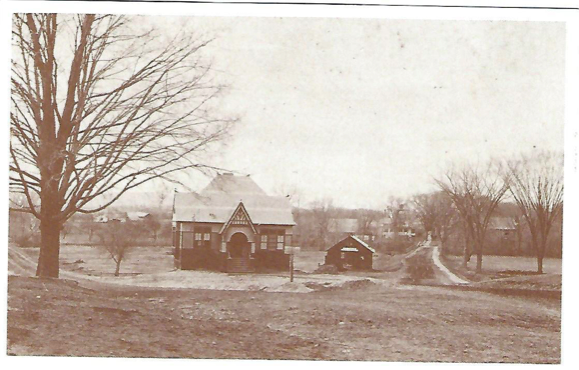HISTORICAL COMMISSION PONDERS DEMOLITION DELAY BYLAW REVISION

North Amherst Library built in 1893 between Montague and Sunderland Roads with Ward Cook’s blacksmith shop to the right. . Photo: Jones Library Archives/ Friends of the Jones Library System
REPORT ON THE AMHERST HISTORICAL COMMISSION MEETING (7/7/20)
The meeting was held via Zoom webcast and was recorded.
Participating: Historical Commission members Jane Wald (Chair), Jan Marquardt, Robin Fordham, Jane Sheffler, Hettie Startup. Absent: Sarah Marshall
Also: Nate Malloy, Ben Breger, and Christine Brestrup from the Planning Department
Chris Skelly, Director of Local Government Programs at the Massachusetts Historical Commission, discussed revising Article 13 of the Zoning Bylaw dealing with Demolition Delay. Malloy stated that the Bylaw is probably 20 years old and has presented many problems in deliberation because of its imprecision on several points.
Skelly said that he has developed a model bylaw, which was distributed to Commission members in their packet. He said that it was clear to him that the Amherst bylaw was developed independently, as it contains many idiosyncrasies. For instance it does not specify the age at which a structure would fall under consideration for demolition delay. It mentions structures and sites, but does not define either. The Commission members found particularly troublesome the phrase in 13.4121 that a structure may qualify for the delay if it “represents an established and familiar visual feature of the neighborhood, village center, or the community as a whole.”
In the first part of the discussion, Skelly presented three ways to designate which structures are of historic significance. The most common criterion is by the age of the building, usually 50 or 75 years old. Amherst uses 50 years, but it is not specified in the Bylaw; it is only in the Historical Commission’s regulations and on the application for demolition. A second method is categorical, meaning the properties are on a list of Cultural Resources or on the National Register of Historic Properties. Skelly does not recommend this method, as the designation is honorific and carries no regulatory significance or legal protection. A third method is list based, with every historically significant property being listed by street address. This is probably the most accurate method and includes younger properties of historical significance, but would require the most maintenance to keep the listing current.
Amherst’s bylaw also does not specify what constitutes a demolition. Is it replacement of windows or trim? Most commonly demolition is specified as removal of one or more exterior walls, removal of 25 percent of the square footage, or removal of the roof. Each community must determine its own definition. As far as “demolition by neglect,” when a property owner fails to maintain a historically significant structure, resulting in its demolition, Skelly recommends making required maintenance of these structures a separate bylaw.
Skelly pointed out that most communities have a two-step process for demolition delay where an application for demolition is reviewed by the Building Commissioner and possibly the chairperson of the Historical Commission to determine the historical significance, if any, of the structure. This administrative step is accomplished fairly rapidly. Then, those structures deemed possibly significant are referred for a public hearing in front of the Historical Commission to determine if they should be Preferably Preserved, meaning preserving the structure would benefit the neighborhood or town. This process requires that the Building Commissioner have specific criteria for determining significance. Most members of the Commission felt that leaving the determination to the Building Commissioner lacks the transparency that residents of Amherst expect.
Though the current process of holding public hearings for all proposed demolitions of possibly historically significant structures is cumbersome, it does allow for input from neighbors and interested parties. Startup pointed out that the process is also an educational opportunity.
Brestrup mentioned that a town councilor has suggested that demolition delay was being used to delay construction of a building that a commissioner felt would not fit in the neighborhood. Skelly felt that this is a reason for design review of the proposed replacement structure.
Skelly did say that the trend is toward longer demolition delay. Many older bylaws have a 6-month delay, but newer bylaws have 12- to 18-month delays. Milton passed a 24-month delay in 2017. These longer delays give towns more time to study the impact of the demolition on the community and, in some cases, to establish a local historic district. This was done for a large, mostly vacant factory building in Springfield that was damaged in the Columbia Gas explosion. It became a one-building local historic district and is now being renovated into lofts.
Contrary to the thinking of some developers and local politicians, historic preservation can be a boon for the economy, enhancing property values and tourism. Outbuildings have been converted to accessory dwellings or tiny houses, benefitting owners and tenants. Skelly emphasized the emotional, environmental, economic, and educational benefits of historic preservation. Marquardt suggested that Amherst’s Historical Commission do outreach to the Town Council on these positive aspects.
The Commission ended the meeting with plans to suggest revisions in the Demolition Delay Bylaw to encompass the above points. Skelly also suggested that the bylaw be part of the General Bylaws, not the Zoning Bylaw, since it applies town-wide, not by zone. This means an appeals process would require only a majority vote, not a two-thirds vote, of the Planning Board or ZBA as would be necessary for an appeal of a zoning decision.
In public comment, Hilda Greenbaum of North Amherst expressed regret about the many old buildings which have been demolished in recent years to make way for unsightly new developments that detract from the historic character of the town and add little to either its economic development or its tax base.
The meeting adjourned at 7:15 p.m.
